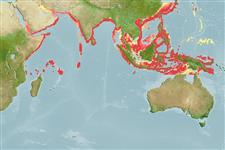Environment: milieu / climate zone / depth range / distribution range
Ecologia
marinhas; estuarina bentopelágico; oceanódromo (Ref. 51243); intervalo de profundidade 50 - ? m (Ref. 9987). Tropical; 31°N - 12°S, 40°E - 153°E (Ref. 54462)
Indo-West Pacific: Somalia to Papua New Guinea, north to Japan and south to Indonesia.
Comprimento de primeira maturação / Tamanho / Peso / Idade
Maturity: Lm ?, range 13 - ? cm
Max length : 61.0 cm TL macho/indeterminado; (Ref. 43449); common length : 25.0 cm TL macho/indeterminado; (Ref. 30573)
Espinhos dorsais (total): 0; Raios dorsais (total): 11-13; Espinhos anais 0; Raios anais : 13 - 15. Scales restricted to posterior half of the body. Posterior tip of pectoral fin reaching origin of pelvic fin.
Inhabit deep water offshore on sandy mud bottom for most of the year, but also gathers in large shoals in deltas of rivers to feed during monsoons (Ref. 9987, 11230). Spawn 6 batches of broods per year (Ref. 43449). An aggressive predator (Ref. 9987). Primarily caught along Maharashtra with the bag-net, better known as 'dol' net. Operation of this gear is timed to a strong tidal current. The bag with the mouth set against the current strains the fish which is being retained therein by the strength of the current. The net is thus retrieved before the tide turns. Very phosphorescent. Excellent food fish. Marketed fresh and dried or salted; consumed pan-fried (Ref. 9987).
Whitehead, P.J.P., 1984. Harpadontidae. In W. Fischer and G. Bianchi (eds.) FAO species identification sheets for fishery purposes. Western Indian Ocean fishing area 51. Vol. 2. [pag. var.]. FAO, Rome. (Ref. 3417)
Status na Lista Vermelha da UICN (Ref. 130435)
Warning: mysqli::__construct(): (HY000/1040): Too many connections in /var/www/html/includes/func_getlabel.php on line 46
Can't connect to MySQL database (fbapp). Errorcode: Too many connections
